SELECTION OF HYBRID WHEAT LINES (TRITICUM AESTIVUM) FOR RESISTANCE TO CHLORIDE SALINIZATION IN IN VITRO CULTURE
DOI:
https://doi.org/10.51452/kazatu.2022.3(114).1175Keywords:
wheat; hybrids; breeding; stability; salinization; regenerating plants; adaptation.Abstract
Wheat, being one of the most important crops in the conditions of the
growing population of the planet, more than others requires careful study and
improvement of approaches to obtaining new varieties and lines. The main
characteristics for selection are both increased quality indicators of wheat and
resistance to environmental stress factors. To date, the area of saline lands in our
country is increasing every year, which leads to a sharp decrease in yield. In this
regard, some regions are experiencing an acute shortage of wheat varieties adapted
to salt salinization. This study analyzes the levels of salt resistance of new wheat
lines from three regions of the country: North Kazakhstan, Akmola and Aktobe.
The paper presents data on the study of the cultural characteristics of 15 new wheat
lines, as well as selection for chloride salinization (50mM, 100mM, 150mM,
200mM). As a result, only 4 lines from the Karaganda region showed a high level
of adaptation to salt stress up to 150 mM (5-15%). Hybrid lines from Aktobe
region 198/224 and 205/212 showed resistance to salinity of 150 mM, 5 and 15%,
respectively. Line 1201 from the North Kazakhstan region showed resistance to
100 mM salinization. 57 regenerating plants resistant to 150 mM salinity level
were obtained. In soil conditions, under conditions of 150 mM salinity, only 10
plants adapted, which will then undergo field tests.

